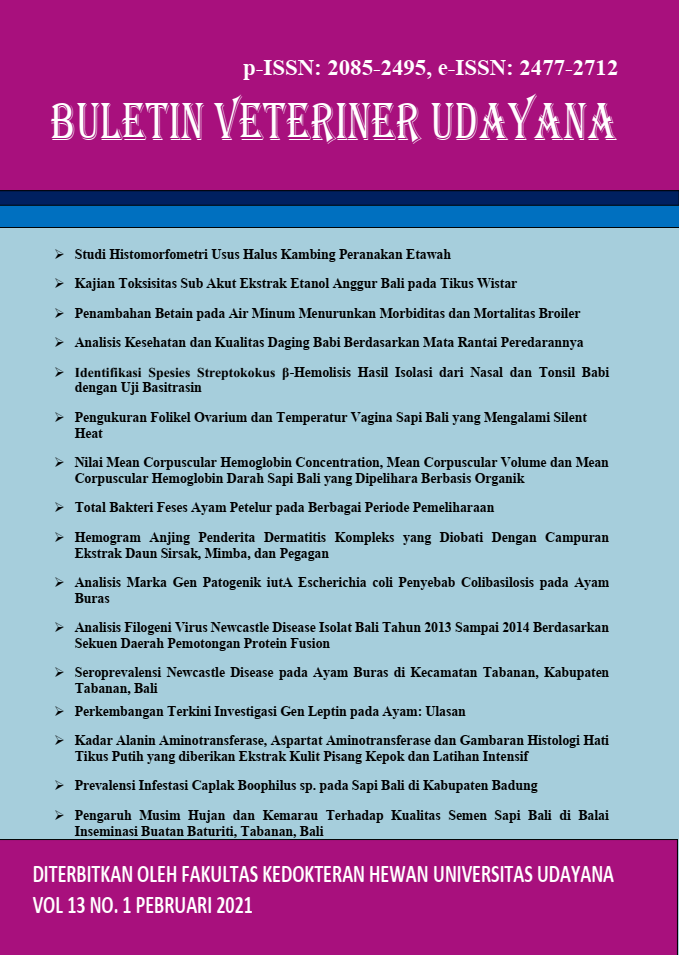TOTAL BACTERIA ON THE FECES LAYER IN VARIOUS AGE GROUPS
Abstract
This study aims to determine the total number of bacteria isolated from laying hens at various ages. The sample used was healthy laying hens' feces with 24 samples using the pouring method. This study uses a completely randomized design (CRD). The data obtained were tested with the Least Significant Difference Test (LSD). The results showed the total number of bacteria in the starter phase of layer was 52.83x107 CFU/ml, grower phase of layer was 208.50x107 CFU/ml, developer phase of layer was 409.5x107 CFU/ml, and layer phases of layer was 208x107 CFU/ml. It can be concluded that the total number of bacteria in the layer is significantly different at each age phase.
Downloads
References
Fardiaz S. 1992. Mikrobiologi Pangan I. Denpasar. PT Gramedia Pustaka Utama.
Hiett KL, Cox NA, and Rothrock MJ. 2013. Polymerase chain reaction detection of naturally occurring Campylobacter in commercial broiler chicken embryos. Poult. Sci. 92: 1134–1137.
Kompiang, IP. 2009. Pemanfaatan Mikroorganisme Sebagai Probiotik Untuk Meningkatkan Produksi Ternak Unggas di Indonesia. Pengembangan Inovasi Pertanian 2(3): 177-191.
Lerner KL, dan Lerner BW. 2003. World of Microbiology and Immunology. Thomson and Gale, USA. Pp. 189.
Mantrawan PCN, Besung INK, Suarjana IGK, Suwiti NK. 2018. total bakteri pada berbagai umur dan lokasi peternakan sapi Bali di Nusa Penida. Buletin Veteriner Udayana. 10(2): 122-126.
Sampurna IP, Nindhia, TS. 2008. Analisis Data dengan SPSS. Udayana University Press. Denpasar.
Soetanto. 2011. Mikrobiologi Rumen. Bahan Kuliah Nutrisi Ruminansia. Jurusan Nutrisi dan Makanan Ternak Fakultas Peternakan Universitas Brawijaya, Malang.
Stanley D, Geier MS, Denman SE, Haring VR, Crowley TM, Hughes RJ, Moore RJ. 2013. Identification of chicken intestinal microbiota correlated with the efficiency of energy extraction from feed. Vet. Microbiol. 164: 85-92.
van der Wielen PW, Keuzenkamp DA, Lipman LJ, van Knapen F, Biesterveld S. 2002. Spatial and temporal variation of the intestinal bacterial community in commercially raised broiler chickens during growth. Microb. Ecol. 44: 286–293.
Wang L, Lilburn M, Yu Z. 2016. Intestinal microbiota of broiler chickens as affected by litter management regimens. Front. Microbiol. 7: 593.
Williamson G, and Payne WJA. 1998. An Introdution to Animal Husbandry In The Tropics. Longmans Group Ltd. London. Pp. 390-392.
Zulfikar. 2013. Manajemen Pemeliharaan Ayam Petelur Ras. Fakultas Pertanian Universitas Syiah Kuala, Aceh.





